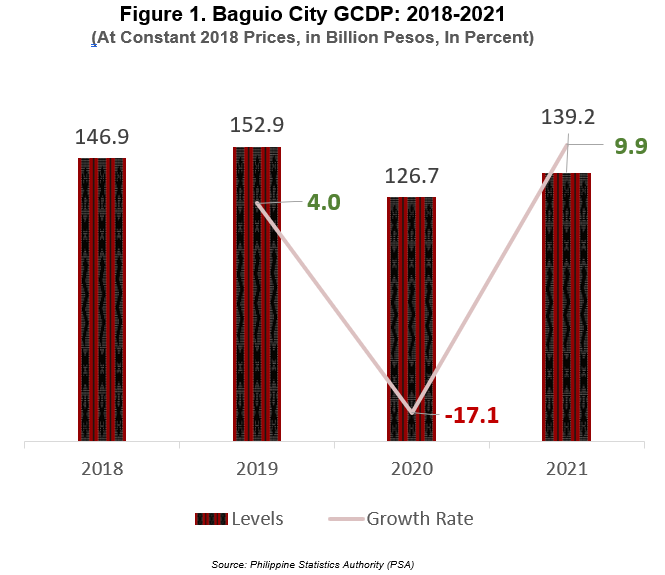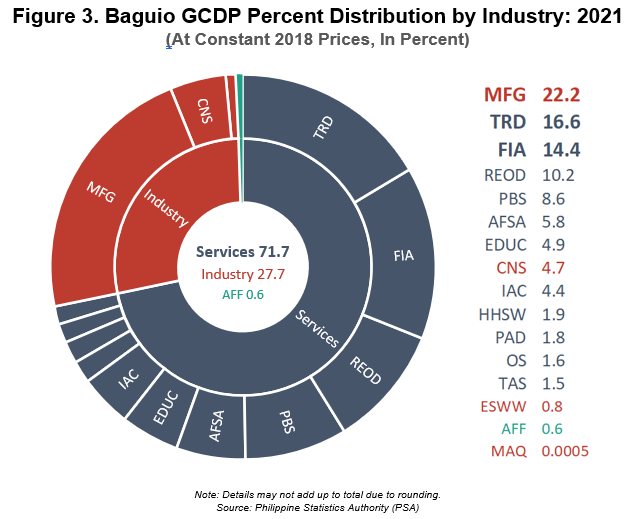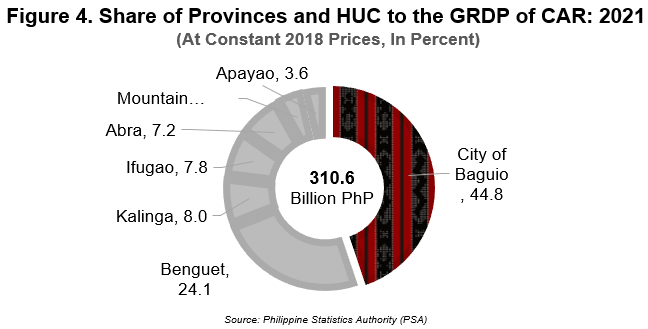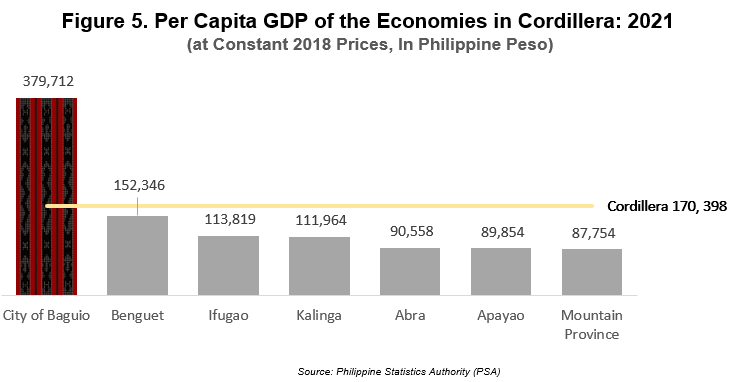|
The Gross Domestic Product (GDP) is a unit to measure the economic performance of a province/highly urbanized city (HUC). It covers the value of goods and services produced in a province/HUC. The Gross Provincial/City Domestic Product (GPDP/GCDP) includes provincial/city estimates on the three major industries of the economy including their sub-industries. The three major industries are Agriculture, Forestry, and Fishing (AFF), Industry and Services. The GPDP/GCDP is presented in nominal and real terms. Nominal GPDP/GCDP measures the value of the outputs of the economy at current prices while real GPDP/GCDP or at constant prices measure the value of economic outputs using the prices of a fixed base year. The GPDP/GCDP is usually reported in real terms or constant prices since the effects of inflation are removed. |
- All major industries contributed to the growth of Baguio City, Industry leading the contribution with 5.1 percentage points.
- The economic structure of the City of Pines was predominantly Services-based, with Manufacturing as the top performing highlighted industry which yielded a contribution of 22.2%.
- City of Baguio ranked 1st among the economies in Cordillera in overall GDP and recorded a per capita that was higher than the region.

Baguio City’s economy grows by 9.9 percent in 2021
The total economic output of the Cordillera increased from the PhP288,876,582 GDP in 2020 to PhP310,587,54 in 2021. This indicated an increase of the gross value added of the production of good and services amounting to PhP 21,710,959.
From a -17.1 decline in 2020, the economy of the City of Baguio bounced back from the COVID-19 pandemic and recorded a growth of 9.9 percent.
Looking at the time series data, the 2021 city gross value added of 139.2 billion Pesos was still lower than the pre-pandemic levels in 2019 and 2018. It can be observed that the GCDP of the City of Baguio recuperated in 2021 but did not yet exceed the 2019 level.

Industry contributes 5.1 percentage points to growth
All the major industries contributed to the 9.9 economic growth of the City of Baguio in 2021. Industry had the biggest contribution with 5.1 percentage points. Services and AFF followed with 4.7 and 0.03 percentage points, respectively.
In 2020, all major industries contributed to the decline of the city’s economy with -17.1 percent of the GCDP. Services was hit the hardest by the pandemic and pulled the economy’s growth down by -11.5 percentage points. This was followed by Industry with -5.6 percentage points and AFF with -0.003 percentage point.
Services and AFF both contributed positively to Baguio City’s economic growth in 2019 with 4.9 and 0.003 percentage points, respectively. Meanwhile, Industry contributed negatively to the economic growth with -0.9 percentage points.

Services comprises 71.7% of Baguio’s economy
In terms of contribution of major industries to the city’s economy, Services accounted for more than half of the city’s total economic output with 71.7 percent share. This was followed by Industry with a share of 27.7 percent, and AFF with only 0.6 percent.
As to distribution of the highlighted industries, Manufacturing was the highest contributor to the city’s economy with 22.2 percent share. The manufacturing of semi-conductor device and other electric components, together with the manufacturing of other air & spacecraft and related machineries propelled the manufacturing sector of Baguio City.
Wholesale and retail trade, repair of motorcycles and motor vehicles had the second largest share, with 23.2 percent and this was brought about by the robust activity in retail trade. Financial and insurance activities followed with 20.1 percent share and it is important to note that with the amount of cash flows happening in the city, the regional office of Bangko Sentral ng Pilipinas – North Luzon transferred from San Fernando, La Union to Baguio City.
On the other hand, the industry with the least proportion to city’s economic output was posted from Mining and quarrying with only 0.0005 percent share.


Baguio ranks 1st in overall GDP
The City of Baguio had the largest share to the economy of the Cordillera with 44.8 percent share or an economic output of PhP139,174,165,000.
The City of Baguio had the highest per capita GDP among the local economies of the Cordillera and was the only economy that surpassed the region’s per capita GDP. In addition, the per capita GDP of Baguio City was the highest among the 13 HUCs piloted in 2022.
VILLAFE P. ALIBUYOG
Regional Director
_____________________________________________________
TECHNICAL NOTES
Gross Provincial/City Domestic Product (GPDP/FCDP)
- The aggregate of gross value added (GVA) of all resident producer units in a province/city.
- Measures the economic performance of the province/city from the perspective of the producers of goods and services. It covers the value of goods and services produced in the region during the reference period.
- GPDP/GCDP measures the relative contribution of the 16 highlighted industries under the Philippine Standard Industrial Classification (PSIC), namely:
- Agriculture, Forestry, and Fishing (AFF)
- Mining and Quarrying (MAQ)
- Manufacturing (MFG)
- Electricity, Steam, Water and Waste Management (ESWW)
- Construction (CNS)
- Wholesale and retail trade; repair of motor vehicles and motorcycles (TRD)
- Transportation and storage (TAS)
- Accommodation and food service activities (AFSA)
- Information and communication (IAC)
- Financial and insurance activities (FIA)
- Real estate and ownership dwellings (REOD)
- Professional, and business services (PBS)
- Public administration and defense; compulsory social activities (PAD)
- Education (EDUC)
- Human health and social work activities (HHSW)
- Other services (OS)
Constant prices
- way of measuring the real change in output. A year is chosen as the base year. For any subsequent year, the output is measured using the price level of the base year. This excludes any nominal change in production and enables a comparison of the actual goods and services produced.
Growth Rate
- refers to the percentage change of a specific variable within a particular time.
Percent Distribution
- means the percentage obtained by dividing the aggregate value of the Share Consideration (determined by reference to the Closing Share Price) by the Aggregate Consideration Value.
Per Capita GDP
- a financial metric of the economic output per person and is calculated by dividing the GDP by its population.

